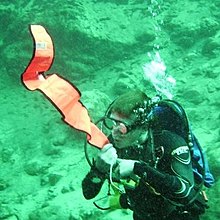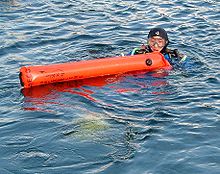
Ice diving is a type of penetration diving where the dive takes place under ice. Because diving under ice places the diver in an overhead environment typically with only a single entry/exit point, it requires special procedures and equipment. Ice diving is done for purposes of recreation, scientific research, public safety and other professional or commercial reasons.
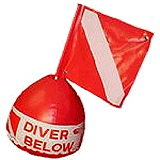
Drift diving is a type of scuba diving where the diver is transported by the water movement caused by the tide, an ocean current or in a river. The choice whether to drift dive depends on the purpose of the dive, and whether there is an option. At some sites there is almost always a current running, and at others the strength and direction of water movement may vary with the tide, or other driving forces, like wind or recent rainfall. At some sites there may be considerable variation in visibility and underwater life activity based on the speed and direction of flow.

A buoyancy compensator (BC), also called a buoyancy control device (BCD), stabilizer, stabilisor, stab jacket, wing or adjustable buoyancy life jacket (ABLJ), depending on design, is a type of diving equipment which is worn by divers to establish neutral buoyancy underwater and positive buoyancy at the surface, when needed.

Diver communications are the methods used by divers to communicate with each other or with surface members of the dive team. In professional diving, diver communication is usually between a single working diver and the diving supervisor at the surface control point. This is considered important both for managing the diving work, and as a safety measure for monitoring the condition of the diver. The traditional method of communication was by line signals, but this has been superseded by voice communication, and line signals are now used in emergencies when voice communications have failed. Surface supplied divers often carry a closed circuit video camera on the helmet which allows the surface team to see what the diver is doing and to be involved in inspection tasks. This can also be used to transmit hand signals to the surface if voice communications fails. Underwater slates may be used to write text messages which can be shown to other divers, and there are some dive computers which allow a limited number of pre-programmed text messages to be sent through-water to other divers or surface personnel with compatible equipment.
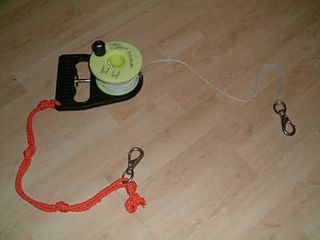
A distance line, penetration line, cave line, dive reel or guide line is an item of diving equipment used by scuba divers as a means of returning to a safe starting point in conditions of low visibility, water currents or where pilotage is difficult. They are often used in cave diving and wreck diving where the diver must return to open water after a penetration when it may be difficult to discern the return route. Guide lines are also useful in the event of silt out.

A diving shot line, shot line, or diving shot, a type of downline or descending line, is an item of diving equipment consisting of a ballast weight, a line and a buoy. The weight is dropped on the dive site. The line connects the weight and the buoy and is used by divers to as a visual and tactile reference to move between the surface and the dive site more safely and more easily, and as a controlled position for in-water staged decompression stops. It may also be used to physically control rate of descent and ascent, particularly by surface-supplied divers.

Scuba diving is a mode of underwater diving whereby divers use breathing equipment that is completely independent of a surface breathing gas supply, and therefore has a limited but variable endurance. The name scuba is an anacronym for "Self-Contained Underwater Breathing Apparatus" and was coined by Christian J. Lambertsen in a patent submitted in 1952. Scuba divers carry their own source of breathing gas, usually compressed air, affording them greater independence and movement than surface-supplied divers, and more time underwater than free divers. Although the use of compressed air is common, a gas blend with a higher oxygen content, known as enriched air or nitrox, has become popular due to the reduced nitrogen intake during long or repetitive dives. Also, breathing gas diluted with helium may be used to reduce the effects of nitrogen narcosis during deeper dives.

A dive boat is a boat that recreational divers or professional scuba divers use to reach a dive site which they could not conveniently reach by swimming from the shore. Dive boats may be propelled by wind or muscle power, but are usually powered by internal combustion engines. Some features, like convenient access from the water, are common to all dive boats, while others depend on the specific application or region where they are used. The vessel may be extensively modified to make it fit for purpose, or may be used without much adaptation if it is already usable.

Diver rescue, usually following an accident, is the process of avoiding or limiting further exposure to diving hazards and bringing a diver to a place of safety. A safe place generally means a place where the diver cannot drown, such as a boat or dry land, where first aid can be administered and from which professional medical treatment can be sought. In the context of surface supplied diving, the place of safety for a diver with a decompression obligation is often the diving bell.

Diving equipment, or underwater diving equipment, is equipment used by underwater divers to make diving activities possible, easier, safer and/or more comfortable. This may be equipment primarily intended for this purpose, or equipment intended for other purposes which is found to be suitable for diving use.

In underwater diving, ascending and descending is done using strict protocols to avoid problems caused by the changes in ambient pressure and the hazards of obstacles near the surface such as collision with vessels. Diver certification and accreditation organisations place importance on these protocols early in their diver training programmes. Ascent and descent are historically the times when divers are injured most often when failing to follow appropriate procedure.
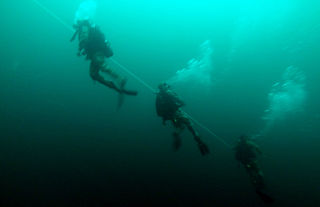
An emergency ascent is an ascent to the surface by a diver in an emergency. More specifically, it refers to any of several procedures for reaching the surface in the event of an out-of-air emergency, generally while scuba diving.

Scuba skills are skills required to dive safely using self-contained underwater breathing apparatus, known as a scuba set. Most of these skills are relevant to both open-circuit scuba and rebreather scuba, and many also apply to surface-supplied diving. Some scuba skills, which are critical to divers' safety, may require more practice than standard recreational training provides to achieve reliable competence.

There are several categories of decompression equipment used to help divers decompress, which is the process required to allow divers to return to the surface safely after spending time underwater at higher ambient pressures.

Surface supplied diving skills are the skills and procedures required for the safe operation and use of surface-supplied diving equipment. Besides these skills, which may be categorised as standard operating procedures, emergency procedures and rescue procedures, there are the actual working skills required to do the job, and the procedures for safe operation of the work equipment other than diving equipment that may be needed.
Investigation of diving accidents includes investigations into the causes of reportable incidents in professional diving and recreational diving accidents, usually when there is a fatality or litigation for gross negligence.

The following index is provided as an overview of and topical guide to underwater diving:
Diving procedures are standardised methods of doing things that are commonly useful while diving that are known to work effectively and acceptably safely. Due to the inherent risks of the environment and the necessity to operate the equipment correctly, both under normal conditions and during incidents where failure to respond appropriately and quickly can have fatal consequences, a set of standard procedures are used in preparation of the equipment, preparation to dive, during the dive if all goes according to plan, after the dive, and in the event of a reasonably foreseeable contingency. Standard procedures are not necessarily the only courses of action that produce a satisfactory outcome, but they are generally those procedures that experiment and experience show to work well and reliably in response to given circumstances. All formal diver training is based on the learning of standard skills and procedures, and in many cases the over-learning of the skills until the procedures can be performed without hesitation even when distracting circumstances exist. Where reasonably practicable, checklists may be used to ensure that preparatory and maintenance procedures are carried out in the correct sequence and that no steps are inadvertently omitted.

Human factors in diving equipment design are the influences of the interactions between the user and equipment in the design of diving equipment and diving support equipment. The underwater diver relies on various items of diving and support equipment to stay alive, healthy and reasonably comfortable and to perform planned tasks during a dive.









